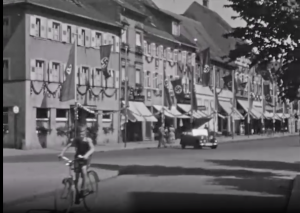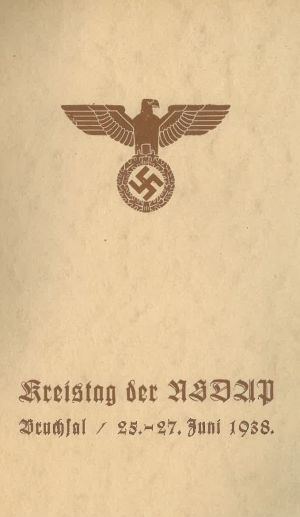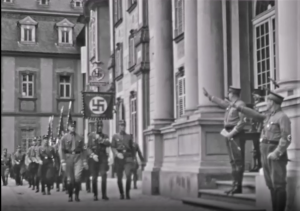Bruchsal NS-Kreistag
Résumé
Contexte et analyse
The first Nazi district assembly in Bruchsal, which took place between June 25 and 27, 1938, is documented in the silent black and white film in 16mm format. It becomes clear how the National Socialists used the city's public space for their propaganda. This served to demonstrate power and underlined the leading role of the party: "The city was like a sea of swastika flags, the streetscape was dominated by garlands and banners" (Walter 2010, p. 19).
The film begins with the logo of the film manufacturer Agfa and the year 1938. The first scene starts with a view of an archway in front of a house with the sign “Kreistag Bruchsal”, above which an imperial eagle with a swastika and swastika flags is enthroned. This is followed by a shot of a building richly decorated with Nazi symbols with swastika flags in front of it. The camera pans to the right, where an SA music corps is marching down the street in front of the 'Gasthof zum Krokodil'. The next sequence shows a shopping street that is also pompously decorated and in the background you can see the baroque parish church of St. Peter. The camera pans the subject with children playing at a fountain several times. Four SA men run towards the well and the camera. An open truck with uniformed men and trailers with material drives past parked cars. Change of scene: A group from the Bund Deutscher Mädel (BDM) stands in a row in front of a richly decorated building with a portrait of Adolf Hitler hanging over the entrance. There is a speech from a Nazi official, which can not be heared. The next shot shows a rondel decorated with swastika flags with an old man and a child with a doll in their arms. In the next picture, uniformed men and a man in civilian clothes are waiting to be admitted to a decorated building. Nazi officials come by car and also go into the building in which an event of the district council is probably taking place.
The following scenes are shot in the inner courtyard of the Bruchsal Palace and cover more than half of the film with over three minutes. According to the program, it is the "SA roll call of Standard 250 in the courtyard of the palace", which took place on Sunday, June 26th at 10 am. The SA troops march with swastika standards and are greeted with a Hitler salute by SA functionaries who stand a little higher on the steps of the castle. After the marched SA troops have walked off, a functionary gives a speech. Standing next to him are the military and the deputy mayor Gebhard Hund in civilian clothes. The SA parade is used to award the SA sports badge to 140 men, as noted in the program booklet (see film “Karlsruhe Sports Festival”). The SA standard 'Kraichgau' can be seen in a close-up. Finally the camera pans over the singing people who have raised their arms in the Hitler salute. With an SA music corps in front, the SA departments and the excellent athletes march past the camera from time to time.
The Bruchsal local branch of the NSDAP was founded on August 5, 1925. In the Reichstag elections in 1930 it was able to establish itself as the second largest party in Bruchsal. 1938 was a year of economic and social upswing - the successes were attributed to Hitler. The district council in Bruchsal was staged accordingly pompous. In the program brochure, NSDAP district leader Emil Epp wrote: “Our first district assembly should be a single report for our entire population on the years of development that have passed. It was a long, rocky road that lies ahead of us today as a smooth road, but all the more proud we can look back on these days. For all of us, the exhibition will be a measure of what we have achieved so far and, at the same time, an incentive for our future work. "
On Saturday, June 25th, the district council and the exhibition were opened by Epp in the Bruchsal Jahnturnhalle at 10 a.m. At 4 p.m., the leadership of the Bruchsal district met in the large hall of the 'Bürgerhof'. At the end of the day there was a gala performance on the Baden stage in the large Bürgerhofsaal, with the play "October 18th" by Walter Erich Schäfer, which deals with Napoleon's 1813 war of German liberation.
Sunday began with the “Big Awake”, which was followed by an appeal from the political leaders in the Maifeld in front of the Reichpost. Then sixteen different workshops began at the same time. At 10 o'clock the roll call of the 'SA Standard 250' took place, which the film documents. The morning party of the NSDAP was held at 11.15 am, at which the flags of the German Labor Front were consecrated on the Maifeld in front of the Reichspost (see color film “Bruchsal NS Ansprache”). From 11.30 a.m. the food was distributed in the yard of the trade school. From 1.30 p.m. a large rally took place on the Maifeld, followed by a 'propaganda march' through Bruchsal. Then the folk festival started on the Turnvereinsplatz and Kastanienplatz. The aerobatics of the NS-Fliegerkorps represented a high point. In the evening there was dancing in all pubs before the light festival of the city of Bruchsal formed the official end of the event day.
Elaine KohlerLieux ou monuments
Bibliographie
- ↑ Cette fiche est en cours de rédaction. À ce titre elle peut être inachevée et contenir des erreurs.








